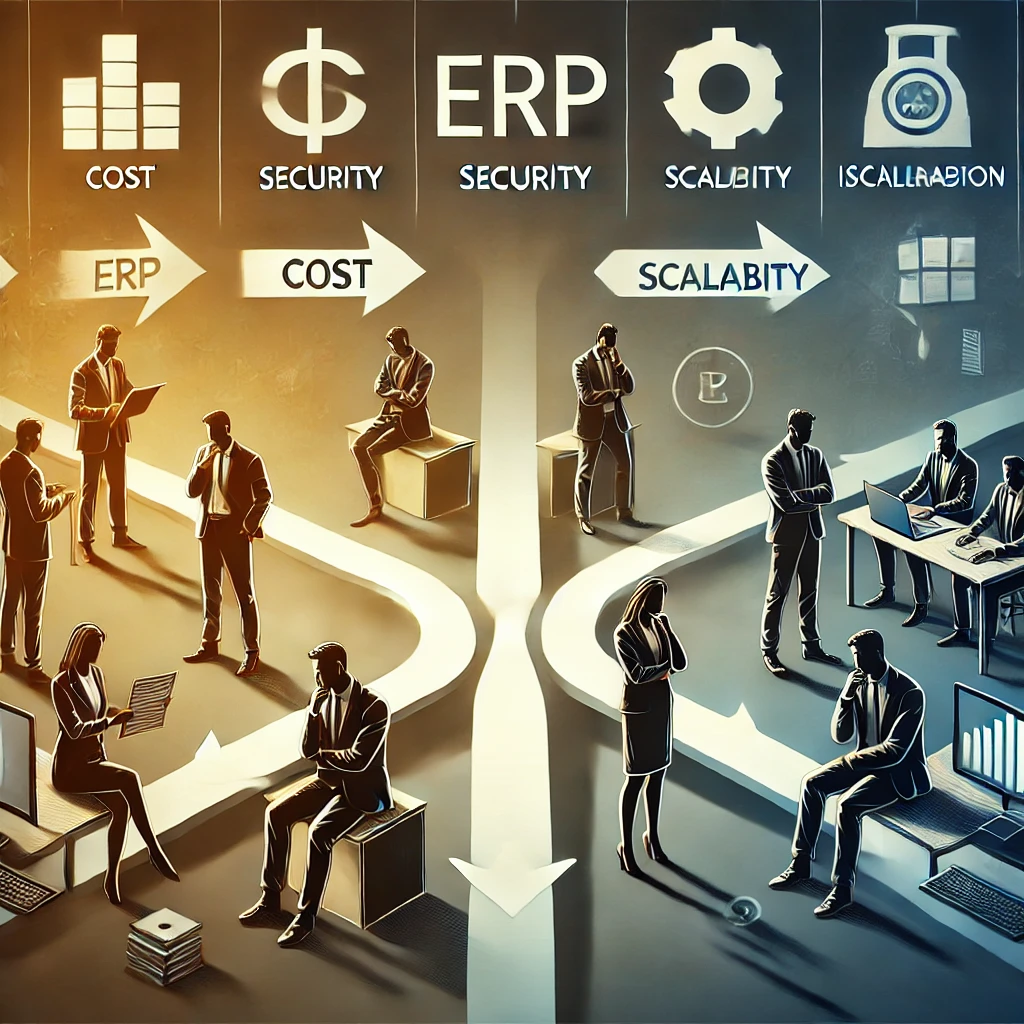Selecting the right Enterprise Resource Planning (ERP) solution is one of the most critical decisions for any organization. The process is fraught with complexities, as the right ERP system can streamline operations, improve efficiency, and drive growth, while the wrong choice can lead to wasted resources and operational inefficiencies. Here’s a breakdown of the key factors contributing to the dilemma of choosing the right ERP solution.
- Understanding Organizational Needs:
- Diverse Requirements: Different departments have unique needs, making it challenging to find an ERP solution that caters to all. But with thorough analysis, one can find what best suits the organization. I have seen clients choosing to incline on the lower side of the cost and facing a lot of difficulties in meeting the needs of the organization.
- Scalability Concerns: An ERP system must not only meet current demands but also scale with the future growth of the company. It should contemplate the rapid growth of the company.
- Customization vs. Out-of-the-Box Solutions: Striking the right balance between a customizable solution and a ready-to-use system is tricky. Customization offers tailored solutions but can be costly and time-consuming. For example, QuickBooks can be used as an off-the-shelf software for inventory but if an organization needs to mold reporting and have better control, they might find Dear Systems more attractive.
- Diverse Requirements: Different departments have unique needs, making it challenging to find an ERP solution that caters to all. But with thorough analysis, one can find what best suits the organization. I have seen clients choosing to incline on the lower side of the cost and facing a lot of difficulties in meeting the needs of the organization.
- Budget Constraints:
- Initial Costs vs. Long-Term Value: Organizations often struggle to justify the upfront investment in an ERP system when the ROI may take years to materialize. This is a tough one as a stable business wouldn’t have such an issue in terms of budget but for startups spending so much this would seem risky.
- Hidden Costs: Implementation often comes with hidden costs, such as training, data migration, and ongoing maintenance, which can strain budgets.
- Initial Costs vs. Long-Term Value: Organizations often struggle to justify the upfront investment in an ERP system when the ROI may take years to materialize. This is a tough one as a stable business wouldn’t have such an issue in terms of budget but for startups spending so much this would seem risky.
- Implementing Vendor:
- Reputation and Reliability: Choosing a vendor with a proven track record is crucial, but newer vendors might offer innovative solutions at competitive prices.
- Support and Training: The level of support and training provided by the vendor can make or break the implementation process. Finding a vendor that offers adequate post-implementation support is essential but not always straightforward. You wouldn’t want to be stuck in a loop and scratching your head when issues are pending at the solution provider’s end.
- Reputation and Reliability: Choosing a vendor with a proven track record is crucial, but newer vendors might offer innovative solutions at competitive prices.
- Implementation Challenges:
- Integration with Existing Systems: Ensuring the new ERP system integrates seamlessly with existing software can be complex and often requires additional resources. But it would keep your operations smooth and effective, plus no additional training would be required for the users.
- Change Management: Employees may resist the new system as they get used to the current operating system, leading to a slower adoption rate and potential setbacks in productivity.
- Time to Implement: ERP implementations can be time-consuming, disrupting normal business operations if not managed properly. Keep in mind implementations take time, it is possible to face some complexities as one dives into the system especially during migration.
- Integration with Existing Systems: Ensuring the new ERP system integrates seamlessly with existing software can be complex and often requires additional resources. But it would keep your operations smooth and effective, plus no additional training would be required for the users.
- Futureproofing:
- Technology Obsolescence: With the rapid pace of technological change, organizations worry about their ERP system becoming obsolete too soon. A new system takes a lot of time and resources so it can not be changed every few years.
- Adaptability: Due to rapid innovations in technology and a constant need for improvement the system must be adaptable to changes in business processes, market conditions, and regulatory requirements, which is difficult to assess during the selection phase.
- Technology Obsolescence: With the rapid pace of technological change, organizations worry about their ERP system becoming obsolete too soon. A new system takes a lot of time and resources so it can not be changed every few years.
- Security Concerns:
- Data Privacy: Ensuring the ERP solution complies with data privacy laws and protects sensitive information is a top priority, but not all solutions offer robust security features.
- Cloud vs. On-Premises: Deciding between a cloud-based ERP and an on-premise solution involves weighing the benefits of accessibility and cost savings against potential security risks. In recent times when a hybrid working environment is gaining pace cloud-based solutions would be more efficient in the future.
- Data Privacy: Ensuring the ERP solution complies with data privacy laws and protects sensitive information is a top priority, but not all solutions offer robust security features.
- User Experience:
- Ease of Use: A user-friendly interface is essential for ensuring that employees can quickly adapt to the new system, but this can be subjective and difficult to evaluate before implementation.
- Mobile Accessibility: With the increasing need for remote work capabilities, mobile accessibility is becoming a crucial factor in the decision-making process.
- Ease of Use: A user-friendly interface is essential for ensuring that employees can quickly adapt to the new system, but this can be subjective and difficult to evaluate before implementation.
Conclusion
Choosing the right ERP solution is a complex and multifaceted process that requires careful consideration of various factors. Organizations must thoroughly assess their needs, budget, vendor options, and potential challenges to make an informed decision. While the process may seem daunting, a well-chosen ERP system can significantly enhance business operations and support long-term growth. It is difficult to keep the harmony between cost and effectiveness but it is achievable and we should find the perfect balance between all the factors discussed.




wonderful article